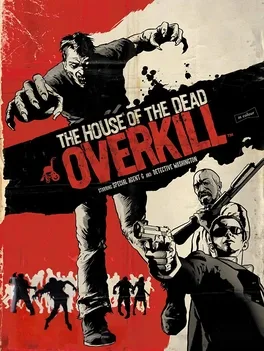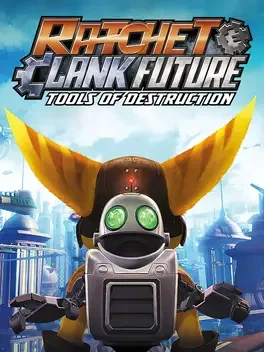(Originally published to Glitchwave on 10/4/2024)
[Image from igdb.com]
The House of the Dead: Overkill
Developer: Headstrong Games
Publisher: Sega
Genre(s): Rail Shooter
Platforms: Wii
Release Date: February 10, 2009
That is to say, Overkill’s presentation and direction are unique in the realm of video games. For the medium of film, too many movies exhibit the tropes that Overkill is paying tribute to count. Many others comment that Overkill is reminiscent of Quentin Tarantino’s works, but the famous director would be paradoxically flattered and offended at the notion that the iconography on display here is definitively his own. The popularity of his film Death Proof along with its double feature slot of Robert Rodriguez’s Planet Terror likely only served as the impetus for creating this game. For those of you who are teenagers who just discovered Tarantino's films after only watching Marvel movies and Madagascar sequels, Overkill’s aura and inspiration are deeply rooted in that of a grindhouse film, an orient of exploitation cinema that stretches back to the days of the medium’s history when Tarantino still had his baby teeth. Exploitation films are inherently centered around the cheap selling points of violence, casual sex, and other forms of depravity, but grindhouse films explicitly revel in these content taboos to the point where they’re all defining characteristics. Overkill understood exactly what buttons it needed to press to evoke the idiosyncratic essentials of a grindhouse film, and they hit every nail on the head.
For starters, the overhead narration that sets the scene of the game is perfect. Our enthusiastic host of the feature presentation introduces our cast of eclectic characters. Overkill’s world has been afflicted with a biological infection called “Formula X” that has transformed the good American people of Louisiana into rabid mutants with a hunger for flesh. Notice how the game never refers to the infected as zombies, which is an admirable choice to distance itself from the obvious hype machine it's attempting to cash on. A suave, stoic man dressed in a dapper suit enigmatically referred to as Agent G has been tasked with hunting down a powerful crime boss named Papa Caesar who might be responsible for the outbreak. At his assistance is the police detective Isaac Washington, whose character delves into the blaxploitation branch of the B-movie family tree. No, I’m not stating this simply because he’s black. The man wears a t-shirt on duty and exclaims the word “motherfucker” more than Samuel Jackson after stubbing his toe. A third member of this squad team is stripper Varla Guns, who has a personal vendetta against Papa Caesar for conducting an experiment on her brother Jasper that transformed him into a hideous monster that ultimately led to his untimely death. The names of these characters alone scream the sleazy nonsense of grindhouse movies if their occupations and designs don’t do enough to hone in on the desired homage. Above all of the shots taken of Agent G and Isaac dueling their weapons akimbo style, an unprofessional way to handle a firearm as a police officer I might add, the indelible proof that the developers did their homework is a shot with the well-endowed Varla driving our two protagonists through the Louisiana countryside at night on her bitchin’ Harley. I’m not sure if it’s the vehicle of choice or if it's the group shot overload of exploitation caricatures all at once, but I have a feeling that I’d suspect that this image alone would ring a grindhouse vibe in my mind without knowing the context. It’s difficult to declare this definitively, for Overkill seems to portray the elements of exploitation film so well that it might trump Tarantino’s understanding of them.
Rail shooters and the Wii’s motion controls are a match made in heaven, even if the inherently violent content of such a genre conflicts with Nintendo’s reputation as a family-friendly brand–especially with the widespread accessibility marketing of this particular system. I’ve already noted how surprising it is that No More Heroes and MadWorld were greenlit to appear on Nintendo’s bundle of multi-million dollar joy, so I’m going to declare that Overkill is part of the gilded club of M-rated Wii titles instead of expressing shock and awe of its exclusivity to the console. If they didn’t want vulgar and graphic content polluting their otherwise pristine system, they shouldn’t have modeled their controller to aim like a gun! But the kinetic relationship between the player’s tangible controller and aiming the deadly virtual weapon in the video game is precisely what makes Overkill especially enjoyable. As par for the course in a rail shooter game, the player’s trajectory through each level is fixed to an automated track set by the developers, and they must splatter the walls with the brains of the “infected” before they get the chance to claw their eyes out or sink their gnarly teeth into the protagonist’s warm human skin. The backdrops of the levels are typical settings for horror films, such as an abandoned plantation home, a carnival, a swamp, a prison, etc. Each location is also framed as a new chapter in the game with electrifying grindhouse titles like “Papa’s Palace of Pain” and “Jailhouse Judgment.” While I understand that the camera controls of a rail shooter are similar to a theme park ride, Overkill’s treatment of the genre’s predestined track sequences is bound to give the player whiplash. The screen shucks and jives to and fro from angle to angle even before the player is finished wiping away the enemies from the previous screen. Still, the erratic tendencies of the generated rail shooter courses are but a minor nitpick to prod at. If it was jarring enough to ruin swiftly turning “infected” into bloody Swiss cheese with five different weapons, something would be seriously wrong.
I think that if the player’s attention starts to wane with Overkill, it’ll be due to the ease of difficulty. Sure, the hordes of enemies ambushing them from every corner of the screen are bound to overwhelm and subdue the player from time to time. However, it’s the fact that succumbing to the onslaught of the undead is a trivial hiccup. The penalty for dying in Overkill is that the player’s score is reduced by half of its total amount, and it’s not as if they’ll receive an irreparable “game over” if their total plummets down to zero. I gather that the developers wanted to maintain the relationship between the rail shooter game and its arcade roots where high scores are what the player strives for. Still, the developers failed to realize that the only person marveling at the player’s accomplishments on a home console is themselves. Overtly drawing conspicuous circles around the weak points of every boss certainly doesn’t inspire dread or panic in the player either. Was there still a strict mandate to dumb down the difficulty to maintain the Wii’s accessibility, even though the game is as profane as an orgy in church?
Speaking of the game’s bosses, I briefly thought Overkill allowed the player to dig out of the facile difficulty rut with its final battle. In a nutshell, Papa Caesar, the villain we’ve been pursuing, has been nothing but a red herring for the prison warden Clement Darling–the true mastermind behind the events of the game. This creepy and sadistic madman reveals that the outbreak was a casualty of his scientific experiments conducted to give his decrepit mother a few additional years on this earth. Before you conclude that his motives are sweet but irrationally conceived, the man had an Oedipus complex a mile wide. You can plainly see with this piece of context why Varla is the ideal specimen to use in a brain swap experiment, and our heroes are too late to prevent this unholy crossover from occurring. The experiment results in Varla’s body mutating to beastly proportions in more ways than I can detail. Before Agent G and Isaac can put this horrific abomination out of its misery, the game pulls a “scene missing” reel cut and then leaps to what seems like their triumphant victory. For a second, I thought the game had locked me out of some vital content due to not meeting some hidden conditions, a sign that the game actually expected more from the player. Alas, this was instead a fakeout as the player fights the beast anyway, with Agent G and Isaac blowing the facility to smithereens with a detonator and transporting Varla’s brain around in a jar in what is definitively a happy ending. Phooey.
Upon putting Overkill’s lack of player determination into perspective, I’m not sure exactly what I expected from it. The game’s entire identity is parodying a sector of films where the style is the substance, and that style in question is nothing but tawdry trash meant to cater to the audience’s most primal and shameful sources of titillation. I fall in the middle of the often non-converging Venn diagram of gamers who are aware of and appreciate the grindhouse films that the game knocks right out of the park in terms of portrayal. For those alien to the game’s stylistic inspirations, I don’t blame them for seeing Overkill as an average rail shooter slightly elevated by the system’s more kinetically involved hardware. Given that the game is at least competent, I still thoroughly enjoyed every moment of The House of the Dead: Overkill in its schlocky glory. Its presentation is just too unique to the gaming medium to pass up.




No comments:
Post a Comment